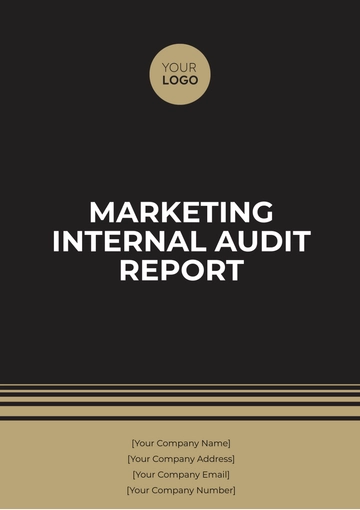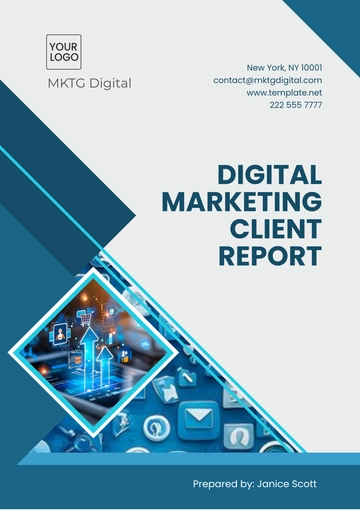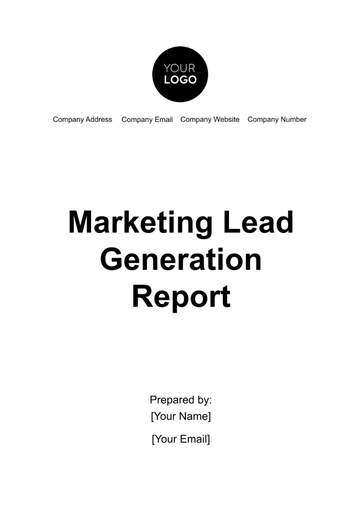Free Email Marketing Campaign Performance Report

I. Executive Summary
A. Overview of the Campaign
The campaign aimed to promote the launch of our client's new product line, targeting previous customers and potential leads through personalized email offers. The campaign utilized AI-driven segmentation and dynamic content to engage recipients effectively. The primary objective was to drive conversions and product awareness over a 30-day period.
B. Key Objectives and Goals
The campaign aimed to achieve the following goals:
Increase open rates by [00]% compared to previous campaigns.
Generate at least a [00]% increase in conversions from email traffic.
Drive a [00]% improvement in customer re-engagement.
C. Summary of Key Performance Metrics (KPI)
Overall, the campaign achieved:
Open Rate: [00]% (above the industry average of [00]%).
Conversion Rate: [00]% ([00]% improvement from last campaign).
ROI: [00]% (outperforming initial projections by [00]%).
D. Recommendations and Next Steps
While the campaign exceeded expectations, future efforts could benefit from further refining the email copy for higher personalization. Additionally, A/B testing with more varied subject lines could yield even better results.
II. Campaign Details
A. Campaign Name
"New Horizons: Product Launch Campaign 2050"
This campaign was designed to introduce our client's revolutionary new product line, combining futuristic features with sustainable technology. The campaign was part of a broader strategy to establish the brand as a leader in both innovation and environmental responsibility.
B. Date/Duration of the Campaign
October 1, 2050 – October 31, 2050 (30 days)
The 30-day campaign utilized a phased approach, with an initial awareness phase followed by targeted promotional emails in the final two weeks. The timing coincided with peak shopping periods leading into the holiday season, maximizing visibility and consumer interest.
C. Target Audience/Segmentation
The campaign was targeted at two primary groups:
Existing Customers: These individuals had made at least one purchase in the past year, with a focus on those who had previously purchased related products.
High-Potential Leads: New subscribers and website visitors who had shown interest in similar products or signed up for early product notifications. The segmentation strategy used AI-driven behavioral data to personalize messaging.
D. Campaign Type
This was a promotional campaign aimed at product launch awareness and customer re-engagement. The campaign included a mix of email types: teaser emails, product launch announcements, exclusive offers for early adopters, and follow-up emails with customer testimonials.
E. Email Platform Used
The campaign utilized FutureMail Pro, an advanced email automation platform featuring AI-powered segmentation, personalized content delivery, and real-time performance tracking. The platform’s robust analytics provided detailed insights into customer behavior, driving optimization throughout the campaign.
III. Performance Overview
A. Overall Metrics
The campaign's overall performance exceeded industry benchmarks across key metrics. The open rate of [00]% outperformed the average by over [00]%, driven by optimized subject lines and personalized content. The click-through rate of [00]% also indicates strong engagement, especially for product links and exclusive offers.
B. Revenue and ROI
Metric | Value |
|---|---|
Total Revenue Generated | $450,000 |
Campaign Cost | |
ROI |
The campaign generated a total of $[00] in revenue, surpassing expectations. The return on investment (ROI) of [00]% reflects not only the success of the campaign in driving conversions but also its efficiency in utilizing email marketing resources effectively. This strong ROI indicates that the strategy of using dynamic, personalized content was highly effective.
IV. Engagement Analysis
A. Open Rate Insights
The open rate for this campaign was significantly above the industry average, showing a successful subject line strategy. Emails sent early in the morning (8 AM) yielded the highest open rates, with [00]% of recipients engaging within the first hour. Mobile users accounted for [00]% of the total opens, demonstrating the need for mobile-optimized content.
B. Click-Through Rate (CTR) Insights
The highest CTR was found in emails featuring dynamic product recommendations based on previous purchases. Over [00]% of recipients clicked through to product pages, with a notable spike in engagement from customers aged 30-40. The CTA to "Explore More" generated [00]% higher clicks than the "Shop Now" CTA.
C. Conversion Rate Analysis
The conversion rate of [00]% was particularly strong among returning customers, achieving a [00]% conversion rate. Newly acquired leads had a lower conversion rate of [00]%, which indicates the need for more nurturing emails before direct conversion asks.
V. Subscriber Behavior and Segmentation
A. Subscriber Growth/Attrition
During the campaign, the company gained 12,000 new subscribers, a [00]% increase in the overall subscriber base. Unsubscribes totaled [00]%, much lower than previous campaigns, indicating higher relevance and engagement from the email content.
B. Segmentation Performance
The existing customer segment significantly outperformed new leads, showing the effectiveness of targeting high-value customers. Further segmentation within the new leads group could help refine future campaigns.
C. A/B Testing
Two versions of the subject line were tested:
Version A: "Discover the Future of [Product]"
Version B: "Your Exclusive Preview of [Product]"
Version B outperformed with a [00]% open rate, indicating a stronger appeal to exclusivity.
VI. Campaign-Specific Analysis
A. Subject Line Performance
The "Exclusive Preview" subject line was most effective in capturing attention and generating opens. Personalization (e.g., including the customer’s name or product interests) increased open rates by [00]%.
B. Content and Design Effectiveness
Emails with dynamic product recommendations and personalized copy saw the highest engagement, particularly those that featured interactive elements like 3D product displays. [00]% of recipients engaged with emails that included product demos embedded directly into the email.
C. Call-to-Action (CTA) Performance
"Explore More" was the highest-performing CTA, generating a [00]% click rate. This CTA resonated particularly well with recipients who had previously engaged with similar products. "Shop Now" had a lower conversion rate but was more effective in driving immediate sales for existing customers.
VII. Deliverability and List Health
A. Bounce Rates
The bounce rate was [00]%, which is lower than the industry average. The hard bounce rate was [00]%, indicating a healthy email list.
B. Spam and Complaint Rates
The spam complaint rate was exceptionally low at [00]%. This reflects the campaign's focus on delivering relevant and timely content to recipients.
C. List Hygiene and Engagement Scoring
Subscribers who interacted with at least [00]% of the campaign emails were tagged as "engaged" and accounted for [00]% of total conversions. The remaining [00]% came from subscribers with lower engagement scores.
VIII. Comparisons to Previous Campaigns
A. Historical Performance Comparison
This campaign outperformed previous campaigns in open rates, CTR, and conversion, showing that improvements in targeting and personalization strategies are paying off.
IX. Recommendations for Future Campaigns
A. Insights and Takeaways
Personalization and segmentation were key drivers of success.
Early morning sends (8 AM) had the highest engagement rates.
Further A/B testing on CTAs and subject lines could yield even better results.
B. Strategy Adjustments
Focus on more granular segmentation for new leads to increase conversion.
Experiment with more video content embedded in emails for future campaigns.
C. Testing and Experimentation Recommendations
Test different send times (e.g., noon vs. 8 AM).
Explore subject line variations based on customer behavior (e.g., urgency vs. exclusivity).
X. Conclusion
A. Summary of Campaign Performance
The "New Horizons" campaign exceeded its goals with strong performance metrics across open rates, CTR, and conversions. The campaign effectively engaged both existing customers and new leads.
B. Next Steps in the Campaign Cycle
Future campaigns should build on the successful tactics of this launch, particularly around personalization and segmentation. Next steps include refining messaging and testing additional elements such as video and interactive content.
C. Key Takeaways for Stakeholders
This campaign highlights the growing importance of personalized content and dynamic email features. The positive ROI further supports investment in advanced segmentation and automation tools for future campaigns.
- 100% Customizable, free editor
- Access 1 Million+ Templates, photo’s & graphics
- Download or share as a template
- Click and replace photos, graphics, text, backgrounds
- Resize, crop, AI write & more
- Access advanced editor
Utilize the Email Marketing Campaign Performance Report Template from Template.net, designed to streamline your reporting process. Fully editable and customizable, this template allows you to tailor the content to suit your unique campaign metrics and branding. With the integrated AI Editor Tool, effortlessly create professional, data-driven reports that make insights clear and actionable.
You may also like
- Sales Report
- Daily Report
- Project Report
- Business Report
- Weekly Report
- Incident Report
- Annual Report
- Report Layout
- Report Design
- Progress Report
- Marketing Report
- Company Report
- Monthly Report
- Audit Report
- Status Report
- School Report
- Reports Hr
- Management Report
- Project Status Report
- Handover Report
- Health And Safety Report
- Restaurant Report
- Construction Report
- Research Report
- Evaluation Report
- Investigation Report
- Employee Report
- Advertising Report
- Weekly Status Report
- Project Management Report
- Finance Report
- Service Report
- Technical Report
- Meeting Report
- Quarterly Report
- Inspection Report
- Medical Report
- Test Report
- Summary Report
- Inventory Report
- Valuation Report
- Operations Report
- Payroll Report
- Training Report
- Job Report
- Case Report
- Performance Report
- Board Report
- Internal Audit Report
- Student Report
- Monthly Management Report
- Small Business Report
- Accident Report
- Call Center Report
- Activity Report
- IT and Software Report
- Internship Report
- Visit Report
- Product Report
- Book Report
- Property Report
- Recruitment Report
- University Report
- Event Report
- SEO Report
- Conference Report
- Narrative Report
- Nursing Home Report
- Preschool Report
- Call Report
- Customer Report
- Employee Incident Report
- Accomplishment Report
- Social Media Report
- Work From Home Report
- Security Report
- Damage Report
- Quality Report
- Internal Report
- Nurse Report
- Real Estate Report
- Hotel Report
- Equipment Report
- Credit Report
- Field Report
- Non Profit Report
- Maintenance Report
- News Report
- Survey Report
- Executive Report
- Law Firm Report
- Advertising Agency Report
- Interior Design Report
- Travel Agency Report
- Stock Report
- Salon Report
- Bug Report
- Workplace Report
- Action Report
- Investor Report
- Cleaning Services Report
- Consulting Report
- Freelancer Report
- Site Visit Report
- Trip Report
- Classroom Observation Report
- Vehicle Report
- Final Report
- Software Report





























